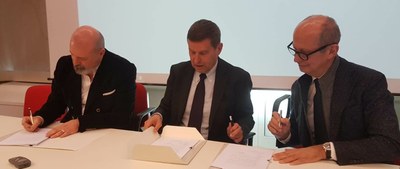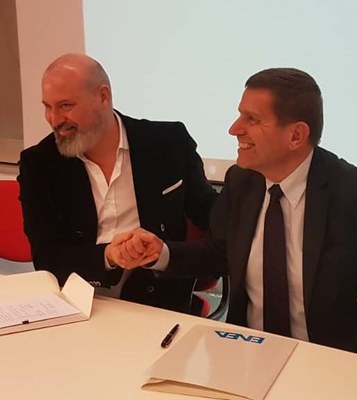New research hub for fusion and radiopharmaceuticals in Italy
24/1/2019
Creating a scientific international hub of excellence on fusion and production of radiopharmaceuticals for the diagnosis and treatment of tumors at the ENEA Brasimone Research Center, halfway between Florence and Bologna. It’s one of the keypoints of the Memorandum of Understanding signed by ENEA and the regional administrations of Emilia-Romagna and Tuscany to promote and valorize the expertise and large experimental equipment of the Center, dedicated to safe and sustainable nuclear technologies.
The announcement made by Canada-the world's largest producer of radiopharmaceuticals- to shut down the reactors producing isotopes for nuclear medicine for reasons of obsolescence, opens up opportunities for other producers. The high cost of building new nuclear reactors is in fact fueling a growing interest in alternative processes. Italy, with its ENEA Brasimone Research Center and a plant to be built at the ENEA Casaccia Research Center, in the Rome area, could play a crucial role.
 In Brasimone, in a first phase the infrastructures needed to experiment with radionuclides production from fusion neutrons will be created. Preliminary studies and experiments are already underway also thanks to EUROfusion funding. Subsequently, the first prototype machine (SORGENTINA RF) will be developed, with the objective of meeting up to a third of the world’s radionuclides needs, such as Technetium- 99, used in more than 30 million diagnostic nuclear medicine procedures around the world each year, for an estimated value of eight billion dollars. In addition to technologies for radiopharmaceuticals, specific projects will be developed related to the fusion reactor DEMO and the DTT - Divertor Tokamak Test, the large science and technology center which will provide answers to some crucial issues of the fusion process, for future production of clean and sustainable energy .
In Brasimone, in a first phase the infrastructures needed to experiment with radionuclides production from fusion neutrons will be created. Preliminary studies and experiments are already underway also thanks to EUROfusion funding. Subsequently, the first prototype machine (SORGENTINA RF) will be developed, with the objective of meeting up to a third of the world’s radionuclides needs, such as Technetium- 99, used in more than 30 million diagnostic nuclear medicine procedures around the world each year, for an estimated value of eight billion dollars. In addition to technologies for radiopharmaceuticals, specific projects will be developed related to the fusion reactor DEMO and the DTT - Divertor Tokamak Test, the large science and technology center which will provide answers to some crucial issues of the fusion process, for future production of clean and sustainable energy .
The Protocol foresees a strengthened collaboration among ENEA, Tuscany and Emilia-Romagna to access national, European and international public and private funds and to promote scientific agreements and collaborations with universities, research centers and high-level technology companies. The joint plan, once implemented, envisages investments up to 100 million euro and the creation of new jobs both at ENEA and in the supply chain.
Additional information on nuclear fusion and the Brasimone Research Center
The Brasimone Research Center counts approximately 90 employees and is one of the major national and international sites for the study and development of technologies and materials for fission safety and nuclear fusion, to produce clean, inexhaustible, safe energy replicating the same mechanism which powers the sun and the stars.
Nuclear fusion – a process opposite to that of nuclear fission - is today globally considered one of the most attractive options for a sustainable energy portfolio. In this sector, Italy has reached a level of excellence internationally recognized and ENEA has achieved a leading role acknowledged by the national scientific community, which includes the main research institutions and several of the most prestigious universities.
Italy is involved in the major international research programs DEMO, Broader Approach and ITER and is a member of the European agencies EUROfusion and Fusion for Energy (F4E).
ENEA is the coordinator of the national fusion research program and the consortium ICAS, which has an active role in the production of components under the Broader Approach and ITER frameworks. The ENEA Nuclear Fusion and Safety Technologies Department is a national and international reference point with its Frascati and Brasimone Research Centers, among the first to build plants for the study of magnetic confinement plasmas, fusion machines like the Frascati Tokamak (FT) and the Frascati Tokamak Upgrade (FTU).
ENEA contributes significantly to the fields of superconductivity, plasma interfaced components, neutronics, security, remote handling and plasma physics. Over the last 20 years it has produced over 50 patents, with significant repercussions on the development and competitiveness of national industries.
Over 500 companies are involved at the industrial level, included Angelantoni Test Technologies, Ansaldo Nucleare, ASG superconductors (Malacalza Group), CECOM, Delata TI, Mangiarotti, OCEM Energy Technology, SIMIC, Vitrociset, Walter Tosto and Zanon. the consortium ICAS (Italian Consortium for Applied Superconductivity) among ENEA, Criotec and Tratos, which have won tenders for over one billion euro, more than 50% of the value of European orders for high-tech components.
